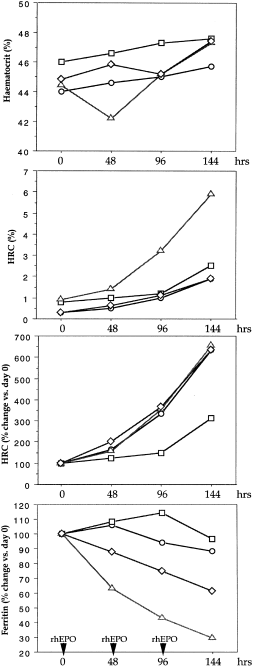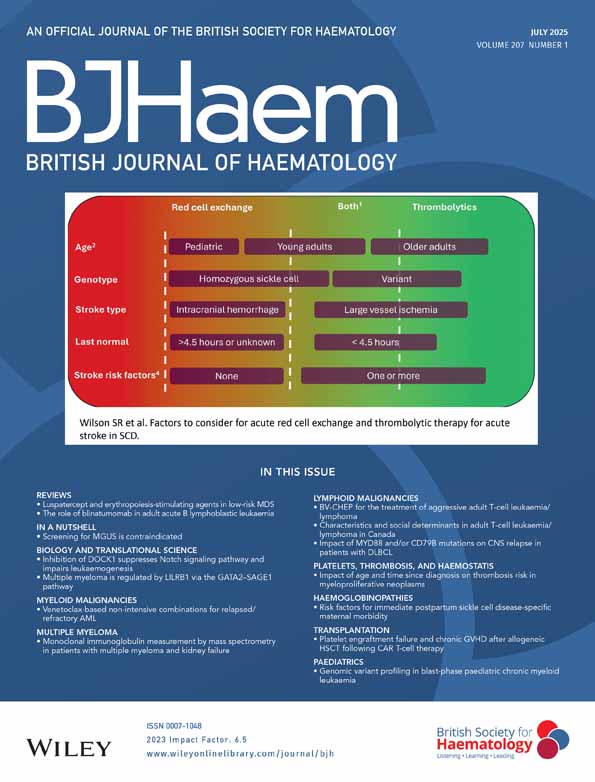‘Blood Doping’ With Recombinant Erythropoietin (rhEPO) And Assessment Of Functional Iron Deficiency In Healthy Volunteers
There is still an ongoing discussion about the usefulness and correctness of haematocrit determinations for the detection of recombinant erythropoietin (rhEPO) doping in athletes.
At present, there are no accepted methods of detecting the use of rhEPO from blood samples, except the UCI (Union Cycliste Internationale) haematocrit cut-off value of 50% (unpublished observations). The cut-off is still questioned because of high individual inter- and intra-day variations and the influence of intravascular fluid shift variations. Studies of iron kinetics after rhEPO use in volunteers ( Breymann et al, 1996 ) suggest that functional iron deficiency, as also proposed by Casoni et al (1993) and Gareau et al (1996) , may be a more sensitive marker of rhEPO abuse than the haematocrit. To investigate short-term pharmacodynamics of rhEPO in relation to iron supplementation, we gave three doses of rhEPO (150 U/kg b.w./48 h) to four healthy male volunteers with normal iron status before therapy. Subjects 1 and 2 were given intravenous iron sucrose (100 mg/injection), subject 3 was given oral iron sulphate (160 mg/day), whereas subject 4 received no iron. Blood samples were assessed before each and 2 d after last rhEPO administration and 1 week later using the Technicon H3 (Bayer, Leverkusen, Germany) analyser for red cell assessment and standard clinical chemistry procedures for ferritin, vitamin B12 and EC folic acid.
After rhEPO treatment, we observed a pronounced increase (up to sevenfold) in hypochromic red cells (HRCs) compared with baseline levels from day 2 onwards in all four volunteers, including the three with iron supplementation ( Fig 1). The increase was most pronounced in the individual without iron supplementation. In contrast, ferritin levels decreased in subjects 2 (i.v. iron), 3 (oral iron) and 4 (no iron). Two weeks after the first rhEPO administration, HRC values had returned to baseline for all three volunteers with iron, whereas the HRC value of subject 4 (no iron) had further increased to 7.7%. Haematocrit levels increased moderately and showed inter-day variations without reaching the ‘athletes'’ limit of 50%.

Fig 1. Short-term changes in haematocrit, hypochromic red cells (HRC) and serum ferritin levels in healthy volunteers during three administrations of rhEPO. (□) Subject 1 (i.v. iron), (○) subject 2 (i.v. iron), (⋄) subject 3 (oral iron), (▵) subject 4 (no iron).
Our investigation showed rapid changes in red cell characteristics 48 h after doses of rhEPO that are presumably much lower than those used by athletes. In spite of normal iron stores before rhEPO and use of parenteral or oral iron, the increase in HRC, reflecting functional iron deficiency, is still seen because the iron is not readily available for haemoglobin synthesis. Magnani et al (1999) have published a report concerning monitoring rhEPO abuse in athletes. They used a cumulative dose of 1000 U/kg/individual and did not detect changes in sTfR and sTfR/ferritin ratios before day 4. The authors conclude that sTfR assay does not detect rhEPO ‘misuse’ when rhEPO is used in low dosages and/or with iron supplementation.
In contrast, we were able to detect changes as early as 48 h after rhEPO, using lower doses of rhEPO and higher doses of oral or parenteral iron. This might indicate that hypochromic red cells are more sensitive in detecting early red cell iron needs after the use or ‘misuse’ of rhEPO. It must be pointed out that athletes often suffer from hypoferricceus (‘sports anaemia’), therefore hypochromic red cells might be elevated without administration of rhEPO. Individual pathological conditions associated with iron deficiency must be ruled out primarily to avoid false positives. Therefore, changes in hypochromic red cells and kinetics in individual athletes in relation to baseline data must be carefully evaluated. Athletes on presumably much higher doses could be expected to show radical individual changes in both parameters on HRC with or without ferritin testing, whereas HRC cut-off values in normal (non-doped) athletes could be used along with the UCI PCV cut-off values to diminish the number of false negatives and positives.




